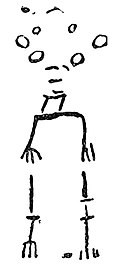even in this abstract symbolism: the circle does roughly resemble the contour of the head: as, indeed, the square or rectangle may  Fig. 3. be said less obviously to do when hair and whiskers and the horizontal line of the hat break the curved line.
Fig. 3. be said less obviously to do when hair and whiskers and the horizontal line of the hat break the curved line.
But it is not the mere contour which represents the face: it is a circle picked out with features. These, however vaguely indicated, are an integral part of the facial scheme. This is illustrated in the fact that among the drawings by savages and others collected by General Pitt Rivers, one, executed by an adult negro of Uganda, actually omits the contour, the human head being represented merely by an arrangement of dark patches and circles for eyes, ears, etc. (Fig. 3).[1]
Coming now to the mode of representing the features, we find at an early stage of this schematic delineation an attempt to differentiate and individualize features, not only by giving definite position but by a rough imitation of form. Thus we get the vertical line as indicating the direction of the nose, the horizontal line that of the mouth, and either a rounded dot or a circular line as representative of the curved outline of the eye—whether that of the iris, of the visible part of the eyeball, or of the orbital cavity. A precisely similar scheme appears in the drawings of savages,[2]
At first the child is grandly indifferent to completeness in the enumeration of features. Even "the two eyes, a nose, and a mouth" are often imperfectly represented. Thus, when dots are used, we may have one or more specks, ranging, according to M. Perez, up to five.[3] The use of a single dot for facial feature in general has its parallel in the art of savage tribes.[4] It is, however, I think, most common to introduce three dots in a triangular arrangement, presumably for eyes and mouth—a device, again, which reappears in the art of uncivilized races.[5] Even when the young draughtsman has reached the stage of distinguishing the features he may be quite careless about number and completeness. Thus a feature may be omitted altogether. This funnily enough happens most frequently in the case of that
- ↑ These drawings, of the highest interest to the student of child-art as well as to the anthropologist, are to be seen in the general's museum at Farnham (Dorset) (seventh room).
- ↑ Schoolcraft has a good example of this facial scheme in the drawing of a man shooting (The Indian Tribes of the United States, vol. i, plate 48).
- ↑ L'Art et la Poésie chez l'Enfant, p. 186.
- ↑ For an illustration see Andree, Eth. Parallelen und Vergleiche, plate 3, Fig. 19.
- ↑ See, for an example, Schoolcraft, vol. iv, plate 28.
